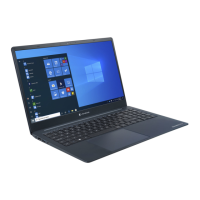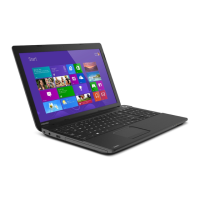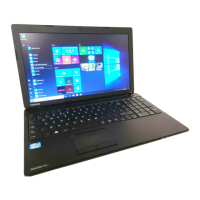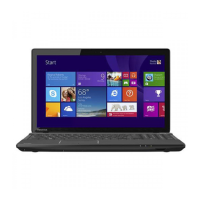
Do you have a question about the Toshiba Satellite C50-C and is the answer not in the manual?
| Operating System | Windows 10 Home |
|---|---|
| Weight | 2.2 kg (4.85 lbs) |
| Optical Drive | DVD Super Multi drive |
| RAM | 4GB DDR3L |
| Storage | 500GB HDD |
| Display | 15.6 inch, 1366 x 768 pixels |
| Battery | 4-cell Lithium Ion |
| Dimensions | 380 x 259.9 x 23.5 mm |
| Connectivity | Bluetooth 4.0 |
| Ports | HDMI, RJ-45, Headphone/Microphone combo jack |
| Graphics | Intel HD Graphics (integrated) |
Legal notices regarding copyright, disclaimers, and registered trademarks.
Compliance information, including FCC, CE, and other regional regulations.
Important safety guidelines for using the computer and preventing injury or damage.
Instructions for environmentally responsible disposal of the computer and batteries.
List of items included with the computer and initial setup verification.
Step-by-step guide to connect the AC adaptor for power and charging.
Instructions on how to safely open and close the computer's display panel.
Procedures for powering the computer on, off, sleep, and hibernation modes.
Introduction to Windows operating system features like Start menu, taskbar, and search.
Steps for creating recovery media and restoring the system in case of issues.
Identification of components visible on the front of the computer when the display is closed.
Identification and description of ports and connectors on the left side.
Identification and description of ports and connectors on the right side.
Identification of components on the back and underside of the computer.
Identification of components visible on the front of the computer when the display is open.
Detailed descriptions of the computer's internal hardware components.
How to use touch screen gestures for interaction and navigation.
How to use touch pad gestures for interaction and navigation.
Description of keyboard layout, special keys, and function key usage.
Instructions for using and maintaining the optical disc drive, including loading and removing discs.
Information on battery types, care, charging, and maximizing battery life.
How to connect to a Local Area Network (LAN) and related cable types.
Step-by-step guide for installing and removing memory modules to upgrade system memory.
How to connect and use external displays, including HDMI port functionality.
How to use the security lock slot to protect the computer from theft.
How to adjust audio settings, microphone levels, and configure video modes.
An introduction to the various software utilities provided with the computer.
Utility for adjusting display settings and enhancing image quality.
Utility for setting and managing user and supervisor passwords for computer security.
Utility for configuring hardware settings, power options, and system behavior.
Information on unique or advanced features that enhance computer usability.
Details on automatic power saving features like HDD power off, sleep, and hibernation modes.
Utility for accessing and modifying BIOS settings and system configuration.
Steps to follow when encountering issues, including preliminary checks and observation.
How to identify if a problem is related to software or hardware components.
Troubleshooting steps for common hardware malfunctions like keyboard, display, and startup problems.
Solutions for issues related to AC power, battery charging, and power down.
Resolving problems with the system date/time and keyboard responsiveness.
Troubleshooting steps for display problems and hard disk drive performance.
Solutions for memory card errors and pointing device (Touch Pad) malfunctions.
Troubleshooting steps for touch pad sensitivity and USB device connectivity.
Steps to resolve issues with LAN, Wireless LAN, and Bluetooth connections.
How to get help, contact support, and prepare for technical assistance.
Technical specifications of the computer, including dimensions and environmental requirements.
Recommended operating and non-operating environmental conditions for the computer.
Details on AC adaptor specifications and power cord connector types for various regions.
Information on wireless technology interoperability and device health considerations.
Compliance statements and regulations from FCC, Industry Canada, and Taiwan.
Features and security mechanisms of Bluetooth wireless communication.
Restrictions and regulations for using radio frequencies in Europe.
Explanations of legal footnotes and CPU performance factors.
Details on system memory capacity and battery life variations.
Specifications for HDD capacity, LCD screen, and Graphics Processing Unit.
Information on wireless LAN transmission speed and media copy protection.
A list of terms and abbreviations used in the manual for reference.








